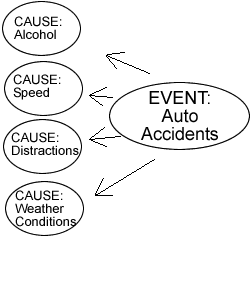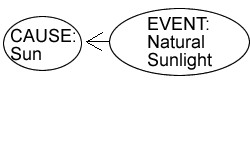|
This strategy has two parts, one to help determine
the cause or causes of events and the other to determine the effect or
effects of events. When analyzing cause-and-effect relationships, you
need to think back and forth. If you are looking for a cause or causes
of an event, you need to think back. If you are looking for an effect
or effects for an event, you need to think forward. Both require you to
start with an event and then reason backward and forward from the event.
The three steps in the first part of this strategy are the same as the
last three steps. They differ in that the first three steps look at causation
and the last three steps look at effects.
|
I dentify an event.
- Clearly identify the event for which
you want to find the cause or causes.
- Write this down so that you are clear
about the starting point of your thinking process.
|
 |
|
F ind
one cause.
- Some events have only one cause. Ask yourself
if this event fits this category.
- Use self-talk or visual aids to clearly demonstrate
to yourself the nature of the cause and effect relationship.
One way to show causation is to write the event and then draw
an arrow to the left of the event and write the cause. This
will show that you are reasoning backward to find the cause
of the event.
- For example, if you are studying the
causes of avalanches and landslides, you will find that there
is one cause; i.e., substances that overcome friction between
the snow or rocks and the underlying ground that holds the snow
or rocks in place on a slope. You might explain this to yourself
by saying: "Substances like
water, ice, and sand overcome friction by making the underlying
surface slippery and providing a cushion that snow or rock can
move over. This movement is an avalanche or landslide."
You also might try to visualize in your mind's eye the actions
that take place with an avalanche or landslide. You might picture
rocks on a slope and water under the rocks carrying them downhill.
|
|
|
F ind
other causes.
- Some events have more than one cause. Ask yourself if this
event fits this category.
- Use self talk or visual aids to clearly demonstrate to yourself
the nature of the cause and effect relationship. Think about
why all the causes are necessary and why one or a few might
not fully explain the event. One technique for visually demonstrating
multiple causation is to write the event and then to the left
of this make a list of all the possible causes of the event.
Draw an arrow from the event back to each of the causes listed.
This will show that you are reasoning backwards to find multiple
causes.
- For example, if you are studying the Salem witch trials, you
may have learned that there were four major reasons for the
trials: the Puritan life style, strong belief in the devil and
witchcraft, the divisions within the Salem village, and expectations
for children. You might explain this to yourself by saying:
"There are four reasons for the Salem
witch trials. First, the Puritan life style had a rigid moral
code that made anyone who did not follow the code suspicious.
Second, the people viewed the devil as equal to God and believed
that witches were possessed by the devil. Third, there were
strong economic and social differences between the people of
Salem and the poorer people who were accused of witchcraft.
And fourth, children were expected to behave as adults. The
two girls who made the accusations of witchcraft were viewed
as little adults."
|
 |
|
I dentify
an event.
- Clearly identify the event for which you want
to find the effect or effects.
- Write this down so that you are clear about
the starting point of your thought process.
|
|
F
ind one effect.
- Some events have only one effect. Ask
yourself if this event fits this category.
- Use self-talk or visual aids to clearly
demonstrate to yourself the nature of the cause and effect relationship.
One way to show effects is to write the event and then draw
an arrow to the right of the event and write the effect. This
will show that you are reasoning forward to project the effect
of the event.
- For example, if you are studying the
effects of drinking and driving, you find that alcohol affects
the nervous system by slowing it down and this eventually results
in decreased ability to drive. You might explain this to yourself
by saying: "The effect
of alcohol on a person's ability to drive is to act like a sedative
and slow down the nervous system."
|
 |
F ind
other effects.
- Some events have multiple effects. Ask
yourself if this event fits into this category.
- Use self-talk or visual aids to clearly
demonstrate to yourself the nature of the cause and effect relationship.
Think about why all the effects are likely and why one or a
few might not be sufficient to explain the relationship. One
way to show multiple effects is to write the event and then
to the right of this make a list of all the possible effects
of the event. Draw an arrow from the event forward to each of
the effects listed. This will show that you are reasoning forward
to project multiple effects.
- For example, if you are studying the
effects of smoking on the inner body, you may have learned that
there are six effects: shortness of breath, coughing, dizziness,
and increased occurrence of cancer, heart disease, and lung
problems. You might explain this to yourself by saying:
"There are six effects of smoking on the inner body. These
are shortness of breath, coughing, dizziness, more cancer, more
heart disease, and more lung problems."
|
 |
|








